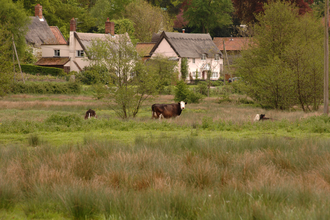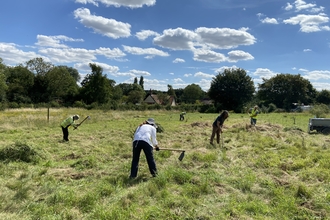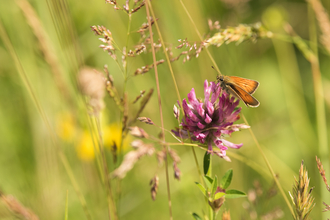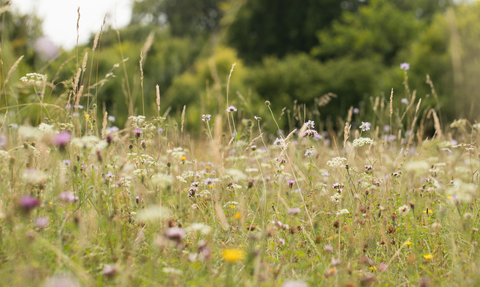
Meadow (credit: James Adler)
Meadows
Meadows are living, breathing places; they are an historically and culturally important part of the landscape. A vital habitat for birds, mammals (including bats), and invertebrates, these species-rich grasslands are particularly important for our precious pollinators due to the range of wildflowers that grow there.
The benefits of meadows reach to the wider environment too as they help to store and ‘sequester’ (remove) carbon, acting as a natural defence against climate change. They also provide increased water retention which can reduce flooding, good quality hay for livestock, and help to connect people with nature which provides physical and mental health benefits.
Sadly, the area of lowland species-rich grassland in the UK has declined by 97% in the past 50 years, so it is crucial that we protect and manage the small fragments of this precious habitat that remain. Some existing grassland areas can be enhanced to increase their species diversity, and therefore their value for other wildlife. We can also create new areas of species-rich grassland to buffer existing grasslands, link habitats, and offer wildlife-friendly habitat in their own right.
Grasslands in Norfolk
Grasslands in Norfolk are remarkably diverse in their origins and, consequently, so are the species living in them. What unites the various grassland types is that all are a product of the interaction of natural factors, such as soil type and availability of water, with human management.
The non-flooded grasslands of Norfolk are mostly all the product of ancient deforestation, followed by centuries of grazing by cattle, sheep, ponies and other livestock. In South Norfolk, on the heavy soils of the Claylands, are extensive old commons with a distinct flora, including national rarities such as sulphur clover. To the west are the extensive dry, grassy heaths on the sands of the Brecks; home to many rare plants including spiked speedwell, Spanish catchfly, Breckland speedwell, bur medick, and Breckland thyme.
In west Norfolk and north Norfolk are small areas of chalk grassland, more typically a habitat of the south of the UK. These sites, including NWT Ringstead Downs and Warham Camp, have diverse flora including squinancywort, dropwort, fairy flax, horseshoe vetch, and pyramidal orchid.
Small patches of any type of dry grassland may be found in gardens, old churchyards, or old paddocks which have never been treated with fertiliser. All benefit from traditional management such as hay-cutting at the appropriate time of year and grazing by livestock.
Species-rich meadows and connectivity
Increasing the connectivity of wildlife-friendly habitats across the landscape is crucial if nature is to recover. Small, isolated habitat fragments cannot sustain long-term populations of most species. It is vital that we link habitats and work to increase their size and quality. The mantra of ‘better, bigger, more and joined’ points us towards a more sustainable future for wildlife.
Meadows have a crucial role to play as they can act as stepping stones for wildlife across the wider countryside. They can provide a hunting ground for species such as barn owl, a vital food source for pollinators, protection from predators, a habitat for species that need grassland as part of their lifecycle (such as great crested newts), and a corridor through the landscape to migrate from one habitat to another. Even fungi such as waxcaps, club, and coral are predominantly found in meadows, proving the importance of meadows for a vast range of wildlife through their connectivity with the wider landscape.
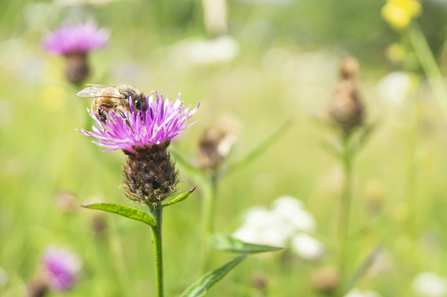
A bee on knapweed (credit: Marcus Wehrle)
Assessing a meadow
Assessing a meadow allows you to determine what is already present, and therefore what appropriate management may be. A grassland survey can be carried out using a range of methods, with varying degrees of complexity, depending on your goal. There are many types of meadow, which may influence the method of assessment. Meadows will vary based on features such as soil type, ranging from acidic through neutral to alkaline (chalky), location, rainfall, and topography.
Survey methods range from simple rapid surveys to complex methods such as National Vegetation Classification surveys.
How to manage established, wildflower-rich meadows
Meadows need consistent management to keep them in a healthy, species-rich state. For landowners, this can involve a summer cut using hay-cutting machinery, potentially followed by grazing with livestock. For communities, this could involve cutting using scythes or mowers. In all cases, the key is to allow the grassland to grow, flower and set seed, during the April to June period, and then cut and remove the grass from the meadow.
Useful links
| More about meadows |
Our handout provides further information on wildflower grasslands Magnificent Meadows shares the importance of meadows including cultural heritage and history. |
|
| Surveying meadows and grasslands |
Magnificent Meadows has produced guides on how to survey and monitor grasslands. |
|
| Managing and maintaining meadows |
Our guide on managing and maintaining grasslands. Magnificent Meadows has produced guides on managing meadows. Plantlife has a wealth of information on maintaining meadows on their Meadows' hub. Coronation Meadows adivce on types of meadow & how they are managed. |
Magnificent Meadows - managing my meadow |

